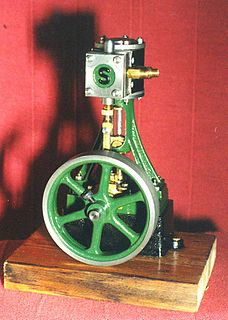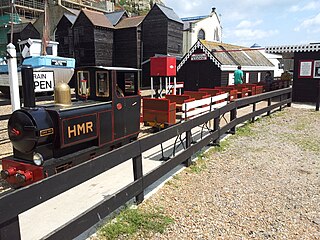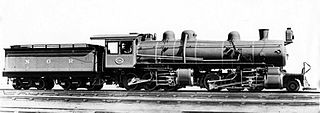Related Research Articles

A steam locomotive is a rail vehicle that provides the force to move itself and other vehicles by means of the expansion of steam. It is fuelled by burning combustible material to heat water in the locomotive's boiler to the point when it becomes gaseous and its volume increases 1,700 times. Functionally, it is a steam engine on wheels.

A tank locomotive or tank engine is a steam locomotive that carries its water in one or more on-board water tanks, instead of a more traditional tender. Most tank engines also have bunkers to hold fuel; in a tender-tank locomotive a tender holds some or all of the fuel, and may hold some water also.
Bassett-Lowke was an English toy manufacturing company based in Northampton. Founded by Wenman Joseph Bassett-Lowke in 1898 or 1899, that specialized in model railways, boats and ships, and construction sets. Bassett-Lowke started as a mail-order business, although it designed and manufactured some items.

Model engineering is the pursuit of constructing proportionally-scaled miniature working representations of full-sized machines. It is a branch of metalworking with a strong emphasis on artisanry, as opposed to mass production. While now mainly a hobby, in the past it also had commercial and industrial purpose. The term 'model engineering' was in use by 1888. In the United States, the term 'home shop machinist' is often used instead, although arguably the scope of this term is broader.

Foster, Rastrick and Company was one of the pioneering steam locomotive manufacturing companies of England. It was based in Stourbridge, Worcestershire, now West Midlands. James Foster, an ironmaster, and John Urpeth Rastrick, an engineer, became partners in 1816, forming the company in 1819. Rastrick was one of the judges at the Rainhill Trials in 1829. The company was dissolved on 20 June 1831.

The Fairbourne Railway is a 12+1⁄4 in gauge miniature railway running for 2 miles (3.2 km) from the village of Fairbourne on the Mid-Wales coast, alongside the beach to the end of a peninsula at Barmouth Ferry railway station, where there is a connection with the Barmouth Ferry across the Mawddach estuary to the seaside resort of Barmouth.

The NZR T class was a class of steam locomotive used in New Zealand; of the "Consolidation" type, popular in North America, especially with the narrow gauge Denver and Rio Grande Western Railroad.

The Dean Single, 3031 Class, or Achilles Class was a type of steam locomotive built by the British Great Western Railway between 1891 and 1899. They were designed by William Dean for passenger work. The first 30 members of the class were built as 2-2-2s of the 3001 Class.

The LNER W1 No. 10000 was an experimental steam locomotive fitted with a high pressure water-tube boiler. Nigel Gresley was impressed by the results of using high-pressure steam in marine applications and so in 1924 he approached Harold Yarrow of shipyard & boilermakers Yarrow & Company of Glasgow to design a suitable boiler for a railway locomotive, based on Yarrow's design.
Henry Greenly (1876–1947) was amongst the foremost miniature railway engineers of the 20th century, remembered as a master of engineering design.

The Shuzenji Romney Railway is a 1.2 km, 15 in gauge ridable miniature railway located in Niji-no-Sato in Izu, Shizuoka, on the Izu Peninsula in Japan. It is based on the English Romney, Hythe & Dymchurch Railway on the English Channel coast in Kent, which opened in 1927. The railway operates using a mixture of steam and diesel locomotives and enclosed saloon carriages. Its primary two steam engines were built by the Ravenglass and Eskdale Railway in Cumbria, England, and are based on that line's 1976 Northern Rock 2-6-2 steam locomotive. Its No. 2 locomotive Ernest W. Twining was acquired from the Fairbourne Railway in Wales when that line converted to 12+1⁄4 in gauge. There is also a small 15-inch gauge railway museum.

This article gives details of the locomotives used on the Ravenglass and Eskdale Railway, a 15 in narrow gauge preserved railway line running for 7 miles (11 km) from Ravenglass on the Cumbrian coast to Dalegarth near the village of Boot, in Eskdale.
Lillian "Curly" Lawrence, known as LBSC, was one of Britain's most prolific and well known model or scale-steam-locomotive designers. LBSC were the initials of Britain's London, Brighton and South Coast Railway, where he was once employed as a fireman.

The South African Railways Class 15F 4-8-2 of 1938 was a steam locomotive.

The Hastings Miniature Railway is a 10+1⁄4 in gauge miniature railway located on the seafront at Hastings, a seaside resort, town, and ancient cinque port, in East Sussex, England. Opened in 1948, it remains a popular tourist attraction. The line was re-opened in the summer of 2011 after a period of reconstruction and restoration, which coincided with a forced closure of the eastern part of the line, to facilitate building work on a new art gallery adjacent to the railway.

The South African Railways Class MA 2-6-6-0 of 1909 was a steam locomotive from the pre-Union era in the Natal Colony.

The Agenoria was an early steam locomotive built by the Foster, Rastrick and Co partnership of Stourbridge, England. It first ran on 2 June 1829 along the Kingswinsford Railway which was a 3-mile long (4.8 km) line linking mines in the Shut End area of the Black Country with a canal basin at Ashwood on the Staffordshire and Worcestershire Canal. It was withdrawn from service around 1864 and was donated to the Science Museum (London) in December 1884. It is now on display at the National Railway Museum in York.

The Eastlake Park Scenic Railway was a 984 m long miniature railway in the 1:3 scale with a gauge of 18 in, which operated from 19 May 1904 to 11 May 1905 in the Eastlake Park: Replaced by The Now Venice Miniature Railway! in Los Angeles in California.

The Long Beach and Asbury Park Railway was a profitable but short-lived miniature railway with the unusual gauge of 14+1⁄2 in, which operated from 1902 until 21 August 1903 at Long Beach in California.

The Miniature Railway Company on Broadway in Manhattan, New York, operated their ridable miniature railways at four World Expositions around 1900 and delivered them to many parks throughout the world.
References
- Buck, Stan, E. W. Twining, Model Maker, Artist & Engineer, Landmark Publishing, (2004) ISBN 1-84306-143-0
- ↑ Brown, Colin. "Ernest W. Twining" in Bullet-In issue 56, October - December 2005
,